View in other NatureServe Network Field Guides
NatureServe
Montana
Utah
Wyoming
Idaho
Wisconsin
British Columbia
South Carolina
Yukon
California
New York
Olympic Dichodontium Moss - Dichodontium olympicum
Other Names:
Olympic Fork Moss
General Description
Plants: Acrocarpous, green, in loose tufts (Lawton 1971). Stems 40-80 mm (FNA 2007).
Leaves: Contorted when dry, spreading when wet (Lawton 1971), the distal end concave, 1-2.2 mm (FNA 2007), narrowly or widely ovate-lanceolate or somewhat lingulate (tongue-shaped) (Lawton 1971), apex widely acute to narrowly rounded-obtuse, sometimes abruptly squared off (FNA 2007); margins entire or frequently finely-waved/denticulate from protruding cell ends (Lawton 1971), usually flat proximally, seldom recurved, quite papillose near attachment and apex but not toothed (FNA 2007).
Leaf Cells: Median laminal cells bearing papillae, sometimes forked, on both faces; costa cells of outer surface quadrate or more rectangular (1-2:1), papillose, resembling the nearby laminal cells (FNA 2007).
Phenology
Capsules ripen in July-October (FNA 2007).
Diagnostic Characteristics
Dichodontium olympicum and D. pellucidum closely resemble one another. The denticulations on the margins of D. olympicum are even; in D. pellucidum, occasional teeth pointing toward the apex interrupt the denticulations (FNA 2007).
Range Comments
Canada: AB, BC; USA: CA, ID, MT, WA (FNA 2007). In Montana: Flathead and Lincoln Counties (Elliott 2016). Type locality from Olympic Mts, Washington (Grout 1928).
Observations in Montana Natural Heritage Program Database
Number of Observations: 3
(Click on the following maps and charts to see full sized version)
Map Help and Descriptions
Relative Density
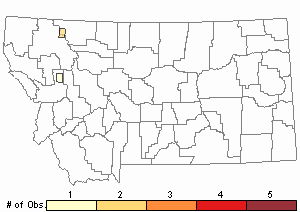
Recency
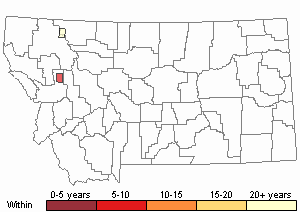
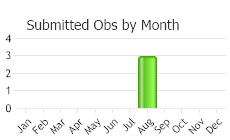
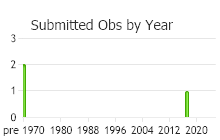
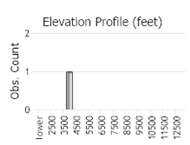 (Observations spanning multiple months or years are excluded from time charts)
(Observations spanning multiple months or years are excluded from time charts)
Habitat
Wet soil and soil over rock (Elliott 2016), a montane species, often linked with snowmelt (FNA 2007).
Reproductive Characteristics
Autoicous (FNA 2007). Seta 4-8 mm. Capsule: 1-1.4 mm, with swelling at base (strumose) (FNA 2007); operculum almost as long as the urn (Lawton 1971).
Stewardship Responsibility
References
- Literature Cited AboveLegend:
 View Online Publication
View Online Publication Elliott, J.C. and A.K. Pipp. 2018. A Checklist of Montana Mosses (1880-2018). Updated 3 January, 2020. Montana Natural Heritage Program, Helena, Montana. 73 pp.
Elliott, J.C. and A.K. Pipp. 2018. A Checklist of Montana Mosses (1880-2018). Updated 3 January, 2020. Montana Natural Heritage Program, Helena, Montana. 73 pp. Flora of North America Editorial Committee, eds. 2007. Flora of North America North of Mexico. Volume 27. Bryophytes: Mosses, Part 1. Oxford University Press, Inc., NY. xxi + 713 pp.
Flora of North America Editorial Committee, eds. 2007. Flora of North America North of Mexico. Volume 27. Bryophytes: Mosses, Part 1. Oxford University Press, Inc., NY. xxi + 713 pp. Grout, A.J. 1928-1940. Moss Flora of North America, North of Mexico. Published by the author, Newfane, Vermont. 3 volumes.
Grout, A.J. 1928-1940. Moss Flora of North America, North of Mexico. Published by the author, Newfane, Vermont. 3 volumes. Lawton, E. 1971. Moss Flora of the Pacific Northwest. Hattori Botanical Laboratory. Japan: Yamabuki-cho, Shinjuku-ku, Tokyo. 362 pages plus appendices.
Lawton, E. 1971. Moss Flora of the Pacific Northwest. Hattori Botanical Laboratory. Japan: Yamabuki-cho, Shinjuku-ku, Tokyo. 362 pages plus appendices.
- Additional ReferencesLegend:
 View Online Publication
View Online Publication
Do you know of a citation we're missing? Elliot, J. C. 1993. Second checklist of Montana mosses. Unpublished report. U.S. Forest Service, Region 1. Missoula, MT. 45 pp.
Elliot, J. C. 1993. Second checklist of Montana mosses. Unpublished report. U.S. Forest Service, Region 1. Missoula, MT. 45 pp. Lawton, E. 1971. Keys for the Identification of the Mosses on the Pacific Northwest. Reprinted from 'Moss Flora of the Pacific Northwest'. Published as Supplement No. 2 of the Journal of the Hattori Botanical Laboratory. Nichinan, Miyazaki, Japan. 66 pp.
Lawton, E. 1971. Keys for the Identification of the Mosses on the Pacific Northwest. Reprinted from 'Moss Flora of the Pacific Northwest'. Published as Supplement No. 2 of the Journal of the Hattori Botanical Laboratory. Nichinan, Miyazaki, Japan. 66 pp.
- Web Search Engines for Articles on "Olympic Dichodontium Moss"





